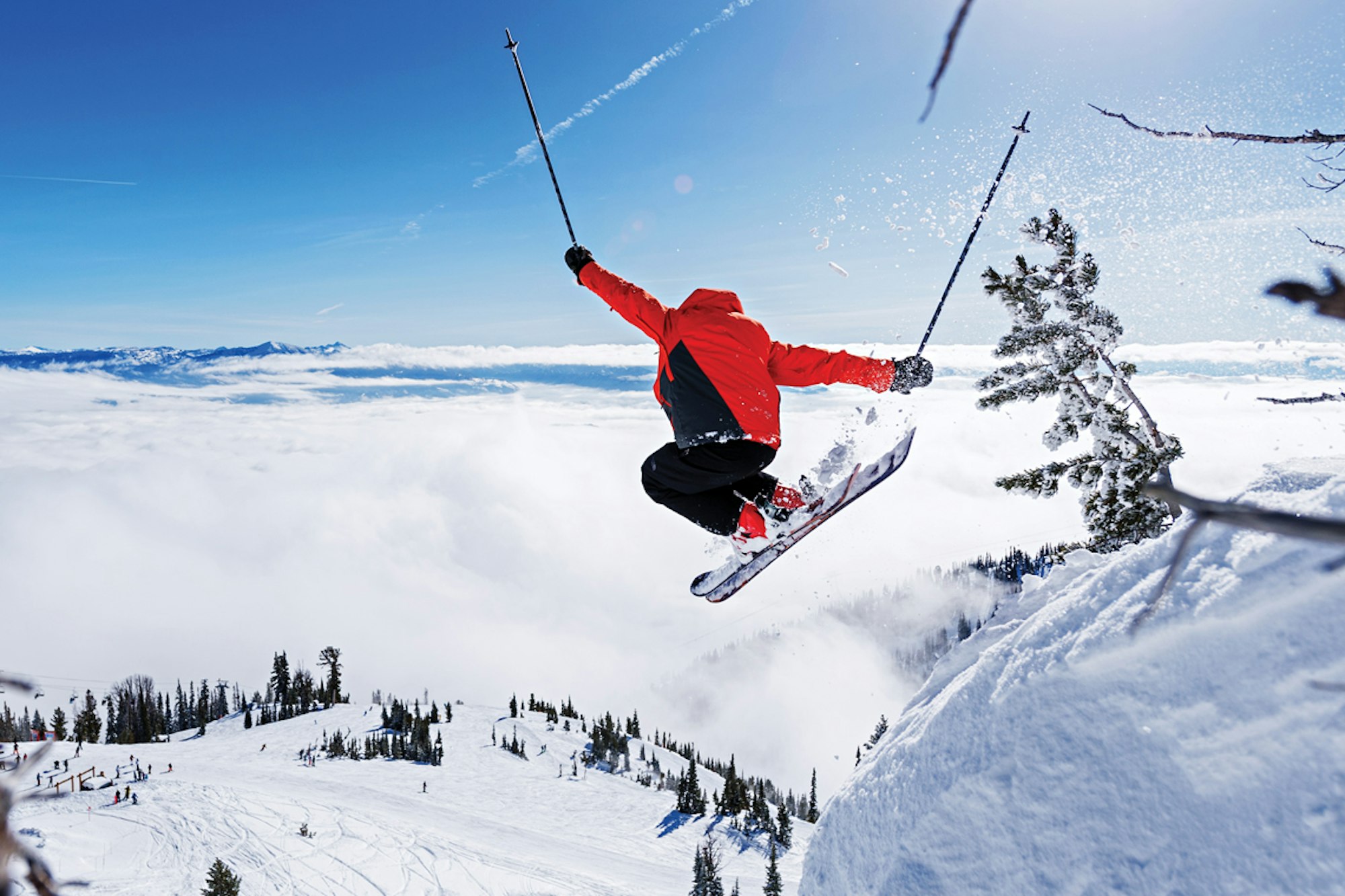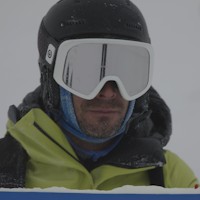Why the attainable is the purest draw of the ski film
The lights dim, the crowd quiets and a collective, palpable excitement fills the room. It’s the premiere of the season’s first ski movie, and the theater is buzzing. Athletes, filmmakers and photographers are in attendance. Underage groms sit on the edge of their seats clutching autographed posters. Curious media representatives and wide-eyed ski enthusiasts wait to see the culmination of a year-long project unfold on the silver screen. Everyone is stirring.
As the opening credits roll, audible hoots and hollers echo through the theater. Captured on film: moving images of the sport’s most talented athletes atop awe-inspiring mountains in far-off destinations; carving fast, arching turns down thousands of feet of untouched snow, sending mandatory airs to Mach speed run-outs, stomping tricks that have never been captured on camera and gasping for air in between neck-deep powder turns. High-octane, blood-boiling action defines the modern ski movie.
Production companies put an emphasis on capturing this kind of footage: the shots that leave your jaw on the floor not only because of the confident, hard-charging skiing that’s occurring but because of the remote location in which it’s taking place. As skiing has evolved, top athletes and filmers have consistently sought out the unknown as their new playground, using planes, helicopters, snowmobiles and their own two feet as means of reaching untouched terrain on which to etch turns. Heading deep into the wilderness, professional skiers and the production crews following them are able to bring extremely faraway places close to home. In that way, we all live vicariously through the athletes we see skiing dream lines in the movies.


Yet every skier’s story begins at the resort. It’s where each of us learn the fundamentals of seeking out fresh snow, arching massive turns, pounding moguls, taking flight and achieving top speed. Backcountry exploits wouldn’t be possible without learning on days inbounds, which is why seeing resort segments on the silver screen resonates so deeply with the entire skiing audience, not just its core. Scenes that take place within the boundary lines of a ski resort have a certain magic to them—they’re relatable in a way that’s tangible and familiar, as if we’re watching everything transpire from the chairlift.
In the beginning of his career, action sports filmmaking pioneer Warren Miller captured skiing in an unadorned fashion—there were no big budgets, plane tickets or movie premieres with bright marquees. Miller made his first film in 1950 with a $427 budget using a 16-millimeter camera on loan from two Hollywood executives he had instructed at Sun Valley Resort. Capturing images of talented skiers he happened to meet at the ski area, including his clients, Miller sought to record his exploits in Idaho’s Sawtooth Range for his own entertainment.
Miller found immense success producing feature-length ski films, providing an easy-going, approachable feel in his movies that gave audiences a window into the world of skiing, an otherwise distant activity for most Americans. Accompanying his moving pictures with his own witty, deadpan commentary, Miller wowed audiences with a unique combination of thoughtful, humorous narrative and unpredictable, awe-inspiring action.
Later, in the 1960s, ’70s and ’80s, more pioneering filmmakers such as Dick Barrymore, Craig Beck and Greg Stump innovated upon Miller’s successful ski movie template. Videotaping legendary skiers like Jean-Claude Killy, Wayne Wong, Scott Schmidt, Glen Plake and countless others, the objective for Barrymore, Beck and Stump was the same as it was for Miller—to capture athletes in their element, recording the sport’s best performers as they seek out the most adrenaline- pumping terrain available.
For skiers in these formative generations, ski movie-making was just a side effect of the skiing itself. Photographers and videographers flocked to North American mountain towns like Squaw Valley, California; Jackson Hole, Wyoming; and Telluride, Colorado; to shoot for the latest movies, but there wasn’t the same urge that is evident today to explore beyond the boundary line, although it did occur. Inbounds runs like the Palisades, Corbet’s Couloir, Schmidiots, the Eagle’s Nest and Senior’s tested these athletes and their equipment to the fullest, and any given McConkey or Schmidt drop-in could be—and often was—groundbreaking.


The athletes featured in those ski movies were standouts in the sense that they were the only ones hitting the biggest lines on the deepest days, but most all of this skiing was done inbounds. Watching those original Warren Miller and Greg Stump films showcases not only the skier’s ability, but also the prized terrain that anyone could go and ski.
As skiing has evolved, however, gear has become increasingly specialized and athletes are more driven than ever to explore the most remote parts of the world’s biggest mountain ranges. Film crews like Level 1 Productions have followed the modern skier’s progression from resort focused to backcountry oriented. “First and foremost, what we’re trying to do is provide an opportunity for our athletes to capture the action that they’re looking to produce,” said Josh Berman, founder of Level 1. “As time has gone on, it’s taken our filming out of the resorts and into the streets and the backcountry.”
As a filmmaker in the industry for more than 20 years, Berman has created some of the most memorable movies in skiing and recognizes the importance of balancing jaw-dropping backcountry and urban footage with more relatable content. “As someone who is a fan of ski movies, the resort segment always resonates with the viewer because [that terrain] is something that they’ve either seen in the past or could visit in the future. It’s very cool to put yourself in the same setting, if nothing else, as some of the athletes you seen on the big screen.”
In a similar fashion, Matchstick Productions has followed its athletes to every corner of the globe in search of fresh tracks and wondrous terrain. Yet Matchstick has always been comfortable filming inbounds, whether at its home resort of Crested Butte or its home away from home, Squaw Valley.
Veteran cameraman and director Scott Gaffney has been a major player in producing more than 20 of Matchstick’s feature-length films and has never neglected to keep the audience in mind when filming and editing each new project. “People really enjoy things they can relate to, and I think it’s important to give them that,” he explains. “It’s a treat to see how ballsy and creative our heroes can be in the terrain we all get to ride every day. I enjoy trying to capture the vibe of rallying a ski area with your buddies. It’s a universal experience and feeling, and showing these star athletes inbounds humanizes them in the process.”
The resort segment is a refreshing and uniquely inspiring inclusion in the modern ski film, and it shines amongst the backcountry footage it’s often sandwiched between. Watching top athletes perform on the big screen is spellbinding; yet slashing blinding snow on the edge of an Alaskan spine is, generally, unrelatable. This is why the resort segment stands out: it entertains in a familiar fashion, exciting audiences by bringing the action back inbounds, back to the common skier, back to the idea that skiing is simple and fun and that’s all that matters.
This story originally appeared in the November 2018 issue of FREESKIER (21.2), The Resort Guide. Click here to subscribe and receive copies of FREESKIER Magazine delivered right to your doorstep.



![[GIVEAWAY] Win a Legendary Ski Trip with Icelantic's Road to the Rocks](https://www.datocms-assets.com/163516/1765233064-r2r26_freeskier_leaderboard1.jpg?w=200&h=200&fit=crop)


![[GIVEAWAY] Win a YoColorado X Coors Banquet Prize Package](https://www.datocms-assets.com/163516/1764877349-long-live-local-cooler-bag2.jpeg?w=200&h=200&fit=crop)
![[GIVEAWAY] Win a Legendary Ski Trip with Icelantic's Road to the Rocks](https://www.datocms-assets.com/163516/1765233064-r2r26_freeskier_leaderboard1.jpg?auto=format&w=400&h=300&fit=crop&crop=faces,entropy)






